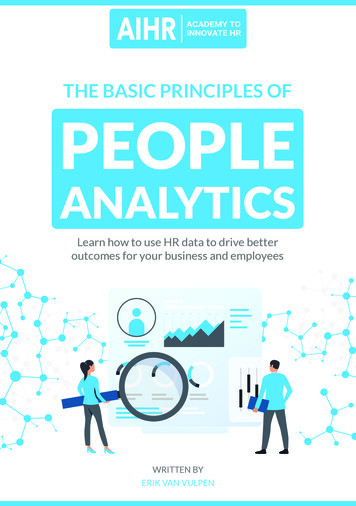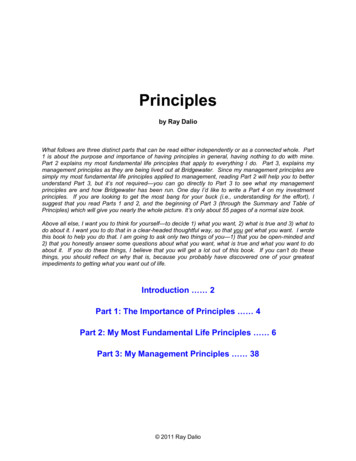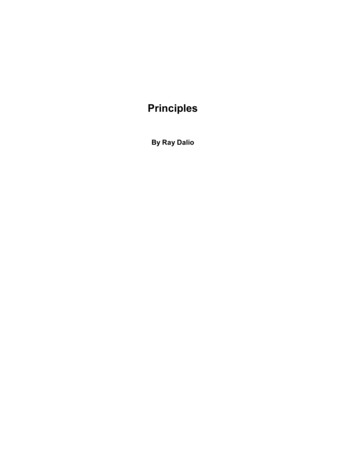
Transcription
THE BASIC PRINCIPLES OFPEOPLEANALYTICSLearn how to use HR data to drive betteroutcomes for your business and employeesWRITTEN BYThe Basic Principles of PeopleERIKAnalyticsVAN VULPENCopyright AIHRPage 1
THE BASIC PRINCIPLES OFPEOPLE ANALYTICSThe Basic Principles of People AnalyticsCopyright AIHRPage 2
THE BASIC PRINCIPLES OFPEOPLE ANALYTICSWRITTEN BYERIK VAN VULPENPUBLISHED BYAIHRwww.aihr.comwww.analyticsinhr.comThe Basic Principles of People AnalyticsCopyright AIHRPage 3
The first edition was published in November 2016This second edition was published in May 2019ISBN: 9781097268757 Analytics in HR B.V.Written by Erik van VulpenCover and image design by Huy TrinhAll rights reserved. No part of this publication may be reproduced and/orcopied without the express written permission of the publisher.Contact the publisher at info@aihr.com.The Basic Principles of People AnalyticsCopyright AIHRPage 4
TABLE OF CONTENTSFOREWORD .61. PEOPLE ANALYTICS.92. PEOPLE ANALYTICS: A BRIEF HISTORY .203. WHY IS PEOPLE ANALYTICS SO POPULAR? .254. PEOPLE ANALYTICS MATURITY .425. TEAM SKILLSETS.496. ASKING THE RIGHT QUESTION.657. SELECTING THE RIGHT DATA .738. DATA CLEANING .799. THE BASICS OF DATA ANALYSIS.9510. INTERPRETATION AND EXECUTION.109CONCLUSION .121REFERENCES .122The Basic Principles of People AnalyticsCopyright AIHRPage 5
FOREWORDThe head of people analytics of a large Fast Moving Consumer Goods company is woken up at 5 in the morning by her ringing phone. After answeringwith a moody “Olivia”, she is surprised to hear it’s the CHRO who tells herto get out of bed and report in the office within the hour. Olivia has workedfor the same company for eight years already, in different roles. She hasnever had her direct manager tell her to report to the office within an hour– let alone at 5 AM.At 5:55 AM the office looks deserted, with the exception of a few seniormanagers who are scurrying past a puzzled looking security officer. He always liked the night shift because he would usually arrive after everyonehad left – and leave early in the morning before everyone arrives. Todayseems, however, different.After arriving in the conference room and greeting her colleagues who areall part of the HR management group, Olivia waits slightly nervous for theCHRO to arrive, who, according to his secretary, is about to finish up anemergency meeting of the board of directors.At 6:05 AM the CHRO walks in. His hair has a suspiciously trendy out-ofbed look – which, Olivia notices with a grin, is hard to pull off for a silverhaired 60-year-old. The CHRO cuts right to the point. The board has beeninformed of a hostile takeover attempt by one of their competitors. Thenews will be public within a few hours and is expected to have a direct impact on the business. The key short-term priorities of the board are to continue business as usual, while the board comes up with and executes a defence strategy.The CHRO notes that HR’s direct contribution is to ensure that employeemorale stays up, monitor anomalies in the workforce, including absenceThe Basic Principles of People AnalyticsCopyright AIHRPage 6
and turnover signals, and to measure the response to the different defencestrategies that will be deployed in the coming weeks. The first order ofbusiness is to measure how employees react to the news and if there issupport for the defence strategies that the board intents to put in place.Olivia has never done so much in one single day. She coordinated with herpeople analytics team and asked them to actively monitor the chatter ontheir internal social network platform. Through sentiment analysis theteam is able to summarize a lot of unstructured information into structuredthemes and assess the associated sentiment. This helps to easily recognizetone of voice, expressed emotions, and the contagiousness of these messages (through measuring comments, upvotes, and other social actions). Inaddition, she worked to prepare a series of pulse surveys that will be sentout every day over the next couple of weeks to measure the attitude towards the takeover company. This type of survey sends out a number ofvery specific questions to a small and randomly selected group of employees to get a proportional reading of employee attitudes while minimizingthe inconvenience of the traditional questionnaire. This pulse survey is alsoa very good tool to test messages on an employee focus group and testtheir perceived impact and tone of voice. So, after a hurried lunch at herdesk she spends two hours with the communications team to coordinateand directly test the wording of a press release scheduled for later that afternoon.After spending well over 12 hours in the office, Olivia takes an Uber todrive her home. She usually goes by public transport – but after an especially busy day like this, the 10-minute car ride is a moment to relax. When thedriver asks her if she takes the taxi service more often, she smiles. A fewdays after the company started working with the sentiment analysis platform that she championed internally, the company had announced their intention to stop the reimbursement of Uber rides. The general sentiment inthe company was so negative after this announcement that, when sheThe Basic Principles of People AnalyticsCopyright AIHRPage 7
showed the numbers to the stakeholders, they decided to reverse the decision the very same day. The relatively low cost of reimbursing these ridesdidn’t weigh up against the resulting sentiment. It was a perfect way toshow how company policy impacted morale on the work floor.In this book, we will demystify people analytics. In the 10 chapters of thisbook we will explain what people analytics is, show its place in the constantly evolving discipline of Human Resources Management, look at howto build a mature people analytics function and show you the differentsteps to be taken to successfully complete a people analytics project.After speaking with well tens – if not hundreds – of HR managers, businesspartners, and CHROs, I have been asked many of the same questions regarding people analytics. In this e-book I will answer these questions andprovide you with a basic understanding of what people analytics is and howit will impact day-to-day activities in the business and in HR.The original version of this book was written in 2016. This second versionhas been revised in April 2019. In this 2019 version, a lot of additional examples have been included. This book is published by AIHR, the largest online academy in the field of people analytics. Enjoy the book and good luckwith your people analytics journey!The Basic Principles of People AnalyticsCopyright AIHRPage 8
1. PEOPLE ANALYTICSBusiness caseGoogle is one of the most innovative companies in the world. After being founded, they experienced astronomical growth. The company expanded to more than20 000 employees in ten years’ time, more than doubling their workforce everysingle year. In 2007, the number of new hires peaked with 200 new employeesevery week.This meant that Google had to spend a tremendous amount of time on recruitingand selecting new employees. Every new applicant was interviewed by the hiringmanager and by their future colleagues. Some managers spent half a week talking to new hires!Since Google invested an extraordinary amount of time in these interviews, theydecided to run the numbers to measure their effectiveness. A small task force ofGoogle data scientists analyzed the predictions that interviewers made about acandidate’s future performance. The task force compared these predictions tothe actual performance of new hires in an effort to find out how accurately theinterviewers could predict performance. The findings were surprising What is people analytics?People analytics is about looking into these numbers. Instead of (or in addition to) relying on gut feeling, people analytics helps organizations to relyon data – just like it helped Google evaluate their hiring process. This datahelps us make better decisions. By analyzing the data, decisions can bemade based on facts and numbers: people analytics is a data-driven approach to managing people at work (Gal, Jensen & Stein, 2017).1The Basic Principles of People AnalyticsCopyright AIHRPage 9
As the example shows, Google thought its managers hired world-class performers. However, this was an assumption they had never tested before.That is quite ‘un-Google-y’. Instead of relying on gut feeling, the head ofHuman Resources (HR) decided to crunch the numbers to see how effective the interview process really was – and how it could be improved. EvenHRM, FINANCE & DATA ANALYTICSPeople analytics is the combination of HRM, data analytics, and financesmall improvements would make a big difference because employees spentso much time interviewing new candidates. These improvements are alsopart of what people analytics is. By adopting a fact-based approach, organi-The Basic Principles of People AnalyticsCopyright AIHRPage 10
zations are able to validate their assumptions on how to best manage people.People analytics is about analyzing organizations’ people problems. HumanResource professionals have long been amassing valuable HR data. Yet despite the value it holds, the data has hardly ever been used. When organizations begin to use this data to analyze their people problems and to evaluate their people policies by connecting them to business outcomes, onlythen they start to engage in people analytics.Since people analytics involves aggregating and analyzing data, it requires askillset that goes beyond those considered ‘traditional’ to HR. People analytics is a combination of Human Resource Management (HRM), finance,and data analytics.Skills needed for people analyticsPeople analytics is an overlap of HRM, finance, and data analytics. Thismeans that organizations need varied skillsets in order to implement people analytics. This involves more ‘traditional’ knowledge such as recruitment, hiring, firing, and compensation. Insight in these HR processes willhelp to make sense of the data that is required to run the analysis but willalso help to make sense of the outcomes of the analysis.Organizations are beginning to realize that a solid understanding of HRpractices is not enough. It is also necessary to be able to analyze the data.This requires a firm foundation in statistic and data analytic techniques. Inthe example, Google analyzed whether interviews predicted future performance. This can be measured by correlating the data, running a regression analysis, performing structural equation modeling, or by using one ofthe many other ways to analyze the data. Some of these techniques workconsiderably better than others. The knowledge required to choose theThe Basic Principles of People AnalyticsCopyright AIHRPage 11
best way of analyzing the data goes beyond the traditional HR practitioner’s skillset. We will talk further about these different data analysis techniques in chapter nine.In order to perform data analysis, you need data. This data often originatesfrom different systems. For instance, to perform their analysis, Google hadto ask their interviewers to rate candidates, as well as collect data fromtheir Applicant Tracking System and their Performance Review System.Thus, people analytics often involves aggregating data from differentsources or systems, this aggregation requires programming skills as well asknowledge of the company’s IT infrastructure. To analyze the data, youneed an analyst with an aptitude for working with data and statistics.Lastly, it is important to communicate effectively with the business. This iskey at the start of analytics, but also when you interpret results. As we willdiscuss later, it is also fundamental to begin with an analytics question thatis important to the business. In addition, when the data analyst relays theirfindings, it is vital to interpret and communicate these results.This can be a challenge because the numbers sometimes contradict themanager’s or HR practitioner’s gut feeling. Transforming the results from‘analytical numbers’ to actionable data visualizations is an often forgottenpart of analytics. Furthermore, the way you communicate the data influences its impact. You can present the data in a meeting, display it in a dashboard or send it in an email. Different ways of communication require different ways of ordering and visualizing the data. This capacity to effectivelycommunicate the data is very important for the successful implementationof analytics.In summary, people analytics goes beyond the skillset that is traditionallypresent in the HR department. The unique combination of skillsets neededfor analytics also makes it challenging to develop an organization’s analytical capabilities. In order to develop these competences, HR should look forThe Basic Principles of People AnalyticsCopyright AIHRPage 12
new hires with different skillsets or work together with departments in theorganization that have these skills in abundance (e.g. Finance and IT). Inchapter five, we will talk more extensively about the skills needed in an effective analytics team – and what will happen when your team lacks certainskills.MISSING SKILLSETSWhat happens if one skillset is missing?People analytics consists of a combination of differentskillsets, some of which are rarely found in HR.The Basic Principles of People AnalyticsCopyright AIHRPage 13
Why is people analytics so important?When you say analytics, most people think of finance or marketing. Theseare fields that already measure everything they can measure. On a website,every button click is recorded, every conversion is measured, and everysale is registered. In fact, a well-oiled Finance Department is able to showthe conversions for every single dollar spent on online marketing.Now I need to recant this statement immediately. The old adage in the early days of marketing was always: “Half the money I spend on advertising iswasted; the trouble is, I don’t know which half”. Although we are very goodat tracking advertisement budgets and revenue coming from ads today, thesame holds true. Conversions on websites are attributed to the impressionthat that person got when they saw the ad in their Facebook feed – but alsowhen that same person then searched for the product and entered thewebsite via a Google advertisement. The thing is that this is a discussionregarding how we should measure. It’s not about if we should measure.That distinction is important, because I’ve almost never heard a similar indepth discussion about HR data which is strange, because people are oftentimes a company’s most valuable and most expensive asset. In general, companies spend around 70% oftheir budget on personnel expenses. This number is even higher for servicefirms and other companies with many highly educated employees. It is peculiar that organizations have almost no data about how effective peoplespending really is, even though it constitutes the majority of the organization’s expenditure. Insight into how these expenses contribute to the organization’s effectiveness is vital for its existence and its competitive edge.This is where analytics comes in. It is a tool to measure the efficiency, effectiveness, and impact of people policies and spending.The Basic Principles of People AnalyticsCopyright AIHRPage 14
As written in our Google example, measuring the effectiveness of peoplepolicies is important and can have far-reaching consequences on how thebusiness is run. Let’s go back to the case we started with at the beginning ofthis chapter.Around the turn of the new millennium, new research showed that interviews did not necessarily predict future performance very well. Indeed,when interviews were not done well, they were a very unreliable tool forselecting new candidates. It turned out that this also held true for Google.Candidates who came to Google for a job talk never had a second chanceof making a good first impression. By the first handshake, the interviewersubconsciously knew whether he liked or disliked the candidate. The interviewer would then spend the next hour looking for cues that would confirmhis/her first impression. It turned out that when a candidate made a badfirst impression it was almost impossible to turn this bad first impressioninto a good second impression.The Google analysts found that the interviewing process did not reliablypredict which candidate would perform better than others. The only thingit did measure accurately was whether or not the interviewer liked thecandidate! That was a big problem because managers at Google spentroughly five to ten hours interviewing every new hire. This means thatsome managers were involved in the hiring process almost on a full-timebasis. A lot of time and money was wasted in inefficient interviewing processes. Yet, despite all that time and effort, managers at Google were nothiring the best people.The analysis also revealed that multiple interviews with the same candidate did not lead to a better estimation of future performance. After thefourth interview, managers were just as good at estimating performance asafter the tenth interview.The Basic Principles of People AnalyticsCopyright AIHRPage 15
Even though hiring at Google did not work as it should have, everyone stillwanted to interview the new guy that was going to replace Jimmy. This waswhen Google acted in a quite un-Google-y way: they forced a top-downdecision and decided that each candidate would undergo no more thanfour interviews.So what does this teach us? The way Google hired was traditional. Managers and employees at Google spent over a hundred thousand hours interviewing new candidates in their first ten years. Only after the data analysts ran the numbers was it discovered that their interviewing system wasvery time-consuming without actually leading to better hires. The numbersshowed that the interview process needed to become more efficient andmore effective.Google solved this challenge by removing human bias as much as possible.They did this by standardizing and automating the interview. In these interviews, an application called qDroid directs the exchange. The interviewer inputs the candidate’s function and asks them questions prompted bythe app. This method ensures that the interview is structured. In addition,the fact that interviewers do not formulate their own questions makes theinterviews a lot less biased. The questions formulated by qDroid have beenextensively tested and have been proven to accurately predict the candidate’s job performance.Furthermore, the interviewers store the candidate’s answers in the app.Then they rate the candidate on several very specific scales.In the end, all this information is converted to a single number – a numberthat has proven to be highly predictive of a candidate’s future performance.2The Basic Principles of People AnalyticsCopyright AIHRPage 16
The future of people analyticsPeople analytics is most important for HR and the CEO. HR data and analytics help HR to make better decisions about the way people are managed.This means that it can potentially impact all HR processes, such as recruitment and selection (as we saw at Google), compensation, learning and development, or firing. Yet, it goes even further than this.BloombergBloomberg, a major financial news and data company, sells terminals for20 000 dollars a year. These terminals provide quick access to the latestnews, sales figures, and other data. Bloomberg tracks all keystrokes onthese terminals, both for their employees and for their customers.3 Thecustomer information can then be used to provide a better and morestreamlined service. The employee information is useful for analyzing howoften people work and how productive they are. Productivity, in this case, ismeasured in keystrokes and in this way Bloomberg is able to analyze whichjournalist produces content the fastest. In addition, Bloomberg trackswhen people check in and out of their 192 offices all over the world. Literature shows that people who arrive later at work are more likely to be absent in the near future or even switch jobs! (Griffeth, Hom & Gaertner,2000)HumanizeAnother company, Humanize, brings analytics even closer to the workers.In order to analyze how people interact and communicate, they are provided with a personal recording device that they can attach to their badges.These devices record people’s posture and tone of voice. As such, the company is able to track who talks to who, and in what tone of voice. TheseThe Basic Principles of People AnalyticsCopyright AIHRPage 17
badges help companies identify the informal structure in the company.Conversations that people have at the coffee machine and during lunchbreak are very important to how the company functions – but they havenever been accurately recorded. Humanize uses all this information todraw social (communication) networks and analyze the quality of the relations between people who interact with each other. According to a Business Insider article on this subject, the company can even track when people are excited about a certain topic.4 When people talk faster and in ahigh-pitched voice, they are more enthused than when they talk slowerand in a lower tone.These examples are amongst the more futuristic examples but analyticsapplies to many day-to-day examples as well. Some questions that can beanswered through analytics include: What is the return on investment in learning and development?Which groups benefit the most/least? Which employees should I hire? How should I compensate my employees so they perform at theirbest? What impact do safety policies have on the number of workplace accidents? Does our free fitness program actually benefit our employees’ healthand happiness? Which of my employees are most likely to leave the company? Andwhy?In the next chapters of this book, we will give you more examples and enable you to build a process for answering the questions that really matterto you and your organization. Our goal is to make you more familiar withThe Basic Principles of People AnalyticsCopyright AIHRPage 18
HR analytics, help you understand what it is and show you how it can helpyour business. In the next chapter, we will discuss a brief history of HR analytics.The Basic Principles of People AnalyticsCopyright AIHRPage 19
2. PEOPLE ANALYTICS: A BRIEF HISTORYTaylorism: Efficiency is KingIn the early 1900s, Frederick Winslow Taylor published a book titled “ThePrinciples of Scientific Management”. In his book, Taylor, who was a mechanical engineer, applied the engineering principles familiar to him to thework that was done by factory employees. According to Taylor, workerswould be more productive when their task matched their personal capabilities, and when there was a reduction in activities and movements extraneous to the task’s completion (Saylor Foundation, 2013)5.One of Taylor’s followers was car manufacturer Henry Ford. Ford was asuccessful businessman who had produced many different cars, which helabeled alphabetically (the first being his Ford Model A). Ford’s newest car,the Model T, was very popular amongst consumers. In its first year of production Ford sold well over 10 000 vehicles.This tremendous demand for cars forced Ford to consider more efficientproduction methods. To achieve this, he hired Taylor to observe his workersand come up with efficiency increasing ways to make new cars. Taylor recommended that larger car parts should remain stationary, while smallerparts would be brought to the car. Ford studied Taylor’s observations andapplied his principles of scientific management to his production process.Furthermore, he decided that the workers should also remain stationary.The car would physically move from workstation to workstation, whereworkers at each station would perform their specialized tasks before thecar was moved to the next station. This process would be repeated until thecar was complete (EyeWitness to History, 2005)6.However, Ford found that to successfully complete their task, some workstations required more time than others. This led him to recalibrate toolingThe Basic Principles of People AnalyticsCopyright AIHRPage 20
techniques in other areas to compensate for the longer waiting times (Saylor Foundation, 2013).Ford continued to optimize this process and in 1913, he had managed tobring the average production time of a Model T down to 93 minutes. As aconsequence, Ford was able to lower the Model T’s price to 575 dollars. By1914, he had captured 48% of the automobile market, selling over ten million cars (Saylor Foundation, 2013). Now, this wasn’t all. Since productionwas so much more efficient, Ford was able to reduce his employees’ ninehour workday to eight hours, while raising their weekly wage from 2.83dollars to 5.00 dollars (Meyer, 1981)7.Human relations movement: why people are importantTaylor’s scientific management theory was one of the first managementtheories that showed the immeasurable business value of optimally deploying human resources. Yet, it also had drawbacks. In the late 1920s, increasing unionization enabled workers to publicly protest of their lack of voiceand autonomy in the production process, as well as the unforgiving workingconditions that forced workers to be at least as fast as their assembly line.At the same time, American social scientist Elton Mayo was conducting hisfamous experiments at a plant in Hawthorne. Mayo was studying the impact of lighting conditions on workers, exposing some workers to higherlevels of illumination than others. When Mayo measured post-interventionproductivity, he found that workers were 25% more productive comparedto when he began the experiments. No matter how physical conditionswere altered, workers were still more productive. What happened?By merely asking workers to participate in their experiments, Mayo’s teamempowered the workers. The workers found themselves to be an important group whose help and advice were sought by the company. This was aThe Basic Principles of People AnalyticsCopyright AIHRPage 21
revolutionary finding and was coined the Hawthorne effect. Where Taylorfocused on production efficiency, Mayo introduced a behavioral element tothe productivity equation and gave rise to the human relations movement,which proposed that workers would be more productive when their socialconditions were satisfied (Wiliamette University, 2016; Chimoga, 2014)8, 9.Prominent researchers of the human relations movement were Maslow,whose hierarchy of needs showed how employees can get the most out ofthemselves, and McGregor with his Theory X and Theory Y. On the onehand, Theory X proposed that people need financial incentives and thethreat of job loss in order to work harder, while Theory Y proposed thatpeople are self-motivated and have a need for work and creativity. BothMaslow and McGregor showed that employees’ feelings, sentiment, andproductivity were affected by their work conditions, like the type of leadership style, management or colleagues they dealt with (Chimoga, 2004;Grant, 2010)10.Personnel managementThe human relations movement instituted an increase in government legislation and worker rights. In addition, both World Wars caused a shortage ofworkers because many left to serve in the military. This resulted in higherwages and high employee turnover. Companies had no choice but to focuson optimizing worker efficiency, and, in turn, this gave birth to modern personnel management as we know it.Within the company, personnel management had a caretaker function: itdidn’t take part in the company’s strategy but focused on the managementand administration of employees in order to fulfill their work-relatedneeds. Keeping employees content was crucial, especially because of theunions’ rising power during the 1950s in both the United States (U.S.) andEurope.The Basic Principles of People AnalyticsCopyright AIHRPage 22
At the end of the 1960s, the quality of life at work became increasingly important. Organizations started to realize that employee wellbeing played akey part in maximizing organizational performance. During that same time,global student protests showed that the role of power and leadership hadchanged. Personnel management became more and more involved with jobdesign and enrichment, while greater focus was placed on employee participation (Lievens, 2011)11.Human Resource ManagementFrom that point on, history shows a growing emphasis on job enrichment,rapid technological progress, surging global competition, and the rise of theservice industry, in which employee’s skills are particularly valuable. Thesefactors pressured the personnel department into changing f
and data analytics. Skills needed for people analytics People analytics is an overlap of HRM, finance, and data analytics. This means that organizations need varied skillsets in order to implement peo-ple analytics. This involves more ‘traditional’ knowled











